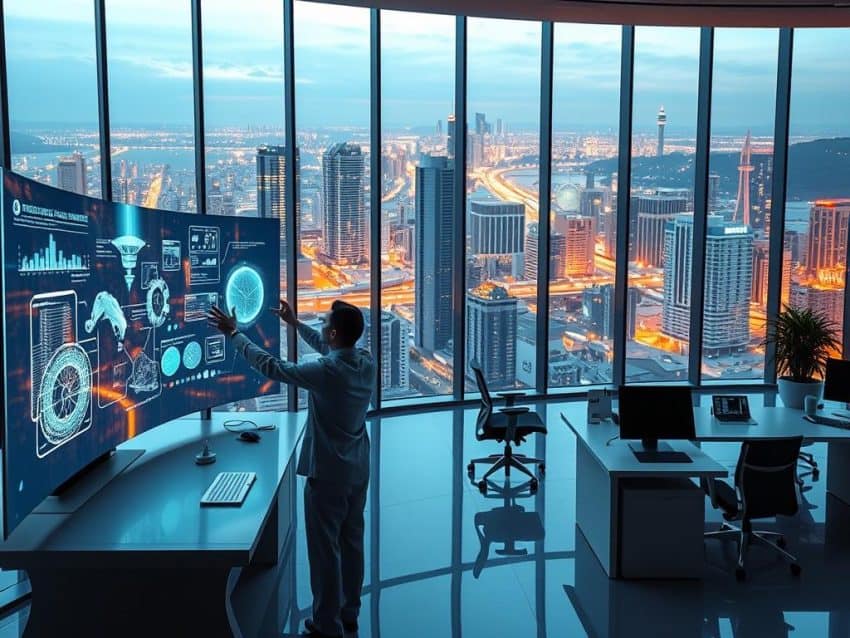Reflecting on my design journey, I see how interactive design trends make a big difference. We’ve all had trouble with messy websites and boring digital interfaces. But, as 2025 approaches, I’m looking forward to a change.
Immersive designs are coming, promising to make our online experiences better. These innovations mix the virtual world with reality. They’re exciting, as people’s expectations grow.
The rise of 3D elements is now key for creating engaging atmospheres. AI-driven interfaces are also changing how we interact with digital spaces. These new interfaces aim to be both beautiful and user-friendly.
Looking ahead, these trends will change how we connect and interact online. They promise to make our digital experiences more meaningful.
Key Takeaways
- 2025 will see a surge in immersive designs blending real and virtual worlds.
- 3D elements will become essential in enriching user engagement.
- AI interfaces will focus on both functionality and aesthetic appeal.
- The design landscape is shifting towards user-centric digital experiences.
- Interactive design trends prioritize intuitive user interaction across platforms.
Emerging Interactive Design Trends for 2025
As we look towards 2025, interactive design is about to change a lot. 3D design elements are becoming more popular, drawing in audiences and making digital content more engaging. This change is thanks to new tech that brings visuals to life and makes interactions more fun.
Focus on 3D Elements
Adding 3D elements to web design is a big deal. These graphics grab attention and let users interact in a more lifelike way. Thanks to better browser tech, these immersive experiences can now work well with online shopping, boosting user time by up to 40%.
3D elements also open up new ways to tell stories, letting users dive into content in a hands-on way.
Rise of AI Interfaces
AI user interfaces are changing the game in design. AI can make interactions more personal, cutting down on people leaving websites. For example, sites using AI for better decisions can see a 25% boost in user satisfaction, tailored to each person’s needs.
As AI designs get better, they promise a smarter, more tailored way to interact online. This means both great looks and solid functionality.
Key UI Design Trends That Enhance User Interaction
The world of UI design is changing fast, with new ways to make user interaction better. Two big trends for 2025 are bento grids and kinetic typography. These ideas make things look good and work better for users.
Bento Grids for Effective Layouts
Bento grids are inspired by Japanese bento boxes. They help create layouts that are flexible and catch the eye. This way, content is organized in clear sections, making it easy to navigate.
With bento grids, finding important info is a breeze. This makes using websites and apps more enjoyable on any device.
Kinetic Typography for Engaging Communication
Kinetic typography adds movement to text, changing how we see information. Designers use animations to highlight messages and guide users. This makes text more engaging and easier to use.
As I see motion in typography, it’s clear it grabs attention. It helps create a stronger bond between users and digital stories.

Interactive Design Trends That Will Shape 2025
Looking ahead to 2025, we see big changes in interactive design. Augmented reality (AR) will make experiences more engaging. It lets users interact with digital stuff in new ways, making content more meaningful.
AR mixes the virtual and real worlds. This creates layers that make content richer and more fun to explore.
Immersive Experiences with Augmented Reality
Augmented reality is key to changing how we interact online. It adds virtual stuff to our real world. This makes experiences more engaging and natural.
AR makes things more fun and interactive. It meets our need for new and exciting experiences.
Progressive Blur for Visual Appeal
Progressive blur will change how we see digital design. It makes transitions smooth, guiding our eyes. This makes content easier to follow and improves our experience.
It makes interfaces feel more alive. This new way of designing will change how we see digital spaces.
Spatial Design Enhancements
Spatial design is getting more attention, thanks to tech like Apple’s Vision Pro. It focuses on depth and movement, beyond 2D screens. This trend makes experiences more immersive and engaging.
Designers using these techniques will create more impactful experiences. This will shape the future of digital interaction.
Conclusion
Looking ahead to 2025, it’s clear that interactive design will see big changes. With over 60% of web traffic coming from mobile devices, the need for responsive designs will grow. I’m excited to use new tech like augmented reality and AI to make digital experiences more personal and engaging.
Also, trends like immersive 3D elements and dynamic micro-interactions will change how we interact with websites. These 2025 trends will help businesses attract more users and boost their success. Together, they aim to create a world where digital and physical spaces feel connected.
The future of interactive design is thrilling. I’m ready to bring these new ideas into my work. Features like voice-activated interfaces and easy login methods will make digital experiences even better. This will keep the focus on the user, sparking creativity and innovation in every project.
